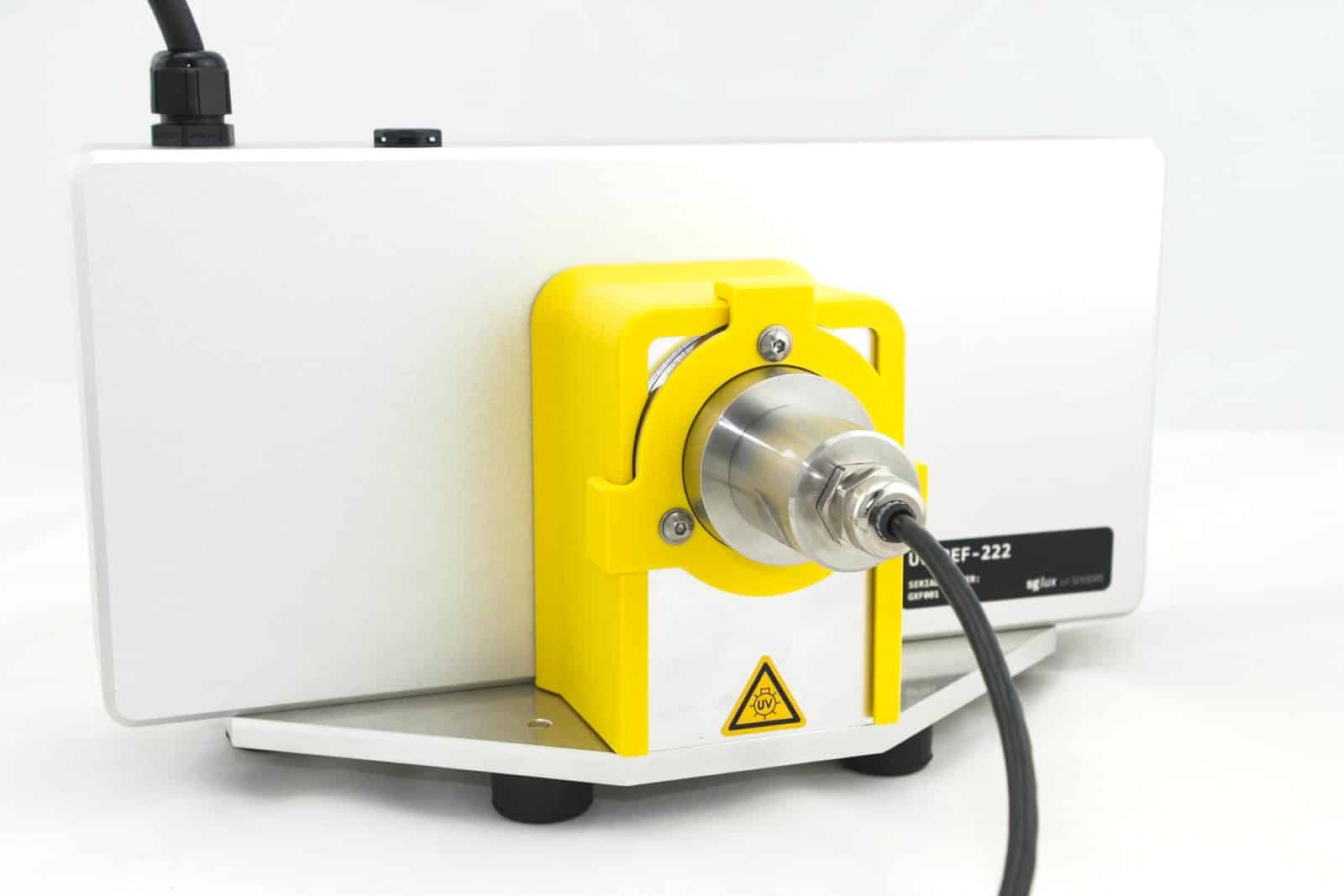
UV-Arc Validation Set
- 222nm Source and Reference Radiometer for arc detecting UV sensors according to EN 50317 consting of:
- current and temperature stabilized KrCl 222nm reference source
- UV Radiometer SXL 55 as display unit
- UV-Arc reference sensor
Publications
2023 – Approaches of LED in-line measurements and its traceable calibration
Gabriel Hopfenmüller, Dr. Niklas Papathanasiou, sglux GmbH, Berlin, Germany
InterAqua Japan 01. – 03.02.2023
Approaches of LED in-line measurements and its traceable calibration
InterAqua Japan 01. – 03.02.2023
Approaches of LED in-line measurements and its traceable calibration
Abstract
UV measurement at UV LED arrays.
2013 – Developing and setting up a calibration facility for UV sensors at high irradiance rates
B. Barton¹, P. Sperfeld¹, A. Towara¹, G. Hopfenmueller²,
¹Physikalisch-Technische Bundesanstalt Braunschweig und Berlin (PTB), 4.1 Photometry and Applied Radiometry, Braunschweig, Germany, ²sglux GmbH, Berlin, Germany
EMEA Regional Conference, Karlsruhe, Germany (2013)
Abstract
PTB provides spectral irradiance calibrations traceable to national primary standards and the SI system. A transfer standard source for high UV irradiances has been constructed and characterized. A medium pressure Hg lamp and a low pressure Hg lamp provide different spectra at different irradiance levels. The system might serve as a calibration facility for DVGW & ÖNORM conform UV sensors. Calibration by direct substitution to reference sensors can be carried out.
¹Physikalisch-Technische Bundesanstalt Braunschweig und Berlin (PTB), 4.1 Photometry and Applied Radiometry, Braunschweig, Germany, ²sglux GmbH, Berlin, Germany
EMEA Regional Conference, Karlsruhe, Germany (2013)
Abstract
PTB provides spectral irradiance calibrations traceable to national primary standards and the SI system. A transfer standard source for high UV irradiances has been constructed and characterized. A medium pressure Hg lamp and a low pressure Hg lamp provide different spectra at different irradiance levels. The system might serve as a calibration facility for DVGW & ÖNORM conform UV sensors. Calibration by direct substitution to reference sensors can be carried out.
2013 – Traceable spectral irradiance measurements at UV water disinfection plants
P. Sperfeld¹, B. Barton¹, S. Pape¹, G. Hopfenmueller²,
¹Physikalisch-Technische Bundesanstalt Braunschweig und Berlin (PTB), 4.1 Photometry and Applied Radiometry, Braunschweig, Germany, ²sglux GmbH, Berlin, Germany
EMEA Regional Conference, Karlsruhe, Germany (2013)
Abstract
PTB provides spectral irradiance calibrations traceable to national primary standards and the SI system. Transportable spectroradiometer systems have been adapted for high UV irradiance measurements. Successful measurements at medium pressure Hg and low pressure Hg lamp facilities have been carried out. The effective microbicidal irradiances agree within 15%. 40° sensor geometry could be developed. Discussion about calibration service and support.
¹Physikalisch-Technische Bundesanstalt Braunschweig und Berlin (PTB), 4.1 Photometry and Applied Radiometry, Braunschweig, Germany, ²sglux GmbH, Berlin, Germany
EMEA Regional Conference, Karlsruhe, Germany (2013)
Abstract
PTB provides spectral irradiance calibrations traceable to national primary standards and the SI system. Transportable spectroradiometer systems have been adapted for high UV irradiance measurements. Successful measurements at medium pressure Hg and low pressure Hg lamp facilities have been carried out. The effective microbicidal irradiances agree within 15%. 40° sensor geometry could be developed. Discussion about calibration service and support.
2013 – PTB traceable calibrated reference UV radiometer for measurements at high irradiance medium pressure mercury discharge lamps
G. Hopfenmueller¹, T.Weiss¹, B. Barton², P. Sperfeld², S. Nowy², S. Pape², D. Friedrich², S. Winter², A. Towara², A. Hoepe², S. Teichert²,
¹sglux GmbH, Berlin, Germany, ²Physikalisch-Technische Bundesanstalt Braunschweig und Berlin (PTB), 4.1 Photometry and Applied Radiometry, Braunschweig, Germany
EMEA Regional Conference, Karlsruhe, Germany (2013)
¹sglux GmbH, Berlin, Germany, ²Physikalisch-Technische Bundesanstalt Braunschweig und Berlin (PTB), 4.1 Photometry and Applied Radiometry, Braunschweig, Germany
EMEA Regional Conference, Karlsruhe, Germany (2013)
2012 – Highly reliable Silicon Carbide photodiodes for visible-blind ultraviolet detector applications
D. Prasai¹, W. John¹, L. Weixelbaum¹, O. Krueger¹, G. Wagner², P. Sperfeld³, S. Nowy³, D. Friedrich³, S. Winter³ and T. Weiss⁴,
¹Ferdinand-Braun-Institut, Leibniz-Institut fuer Hoechstfrequenztechnik, Berlin, Germany, ²Leibniz-Institut fuer Kristallzuechtung, Berlin, Germany, ³Physikalisch-Technische Bundesanstalt Braunschweig und Berlin (PTB), 4.1 Photometry and Applied Radiometry, Braunschweig, Germany, ⁴sglux GmbH, Berlin, Germany
J. Mater. Res., first view (2012).
Abstract
Highly efficient polytype 4H silicon carbide (4H-SiC) p–n diodes for ultraviolet (UV) light detection have been fabricated, characterized, and exposed to high-intensity mercury lamp irradiation (up to 17 mW/cm²). The behavior of the photocurrent response under UV light irradiation using a low-pressure mercury UV-C lamp (4 mW/cm²) and a medium-pressure mercury discharge lamp (17 mW/cm²) has been studied. We report on long-term UV photoaging tests performed for up to 22 mo. Results demonstrate the robustness of SiC photodiodes against UV radiation. The devices under test showed an initial burn-in effect, i.e., the photocurrent response dropped by less than 5% within the first 40 h of artificial UV aging. Such burn-in effect under UV stress was also observed for previously available polytype 6H silicon carbide (6H–SiC) p–n photodetectors. After burn-in, no measurable degradation has been detected, which makes the devices excellent candidates for high irradiance UV detector applications.
¹Ferdinand-Braun-Institut, Leibniz-Institut fuer Hoechstfrequenztechnik, Berlin, Germany, ²Leibniz-Institut fuer Kristallzuechtung, Berlin, Germany, ³Physikalisch-Technische Bundesanstalt Braunschweig und Berlin (PTB), 4.1 Photometry and Applied Radiometry, Braunschweig, Germany, ⁴sglux GmbH, Berlin, Germany
J. Mater. Res., first view (2012).
Abstract
Highly efficient polytype 4H silicon carbide (4H-SiC) p–n diodes for ultraviolet (UV) light detection have been fabricated, characterized, and exposed to high-intensity mercury lamp irradiation (up to 17 mW/cm²). The behavior of the photocurrent response under UV light irradiation using a low-pressure mercury UV-C lamp (4 mW/cm²) and a medium-pressure mercury discharge lamp (17 mW/cm²) has been studied. We report on long-term UV photoaging tests performed for up to 22 mo. Results demonstrate the robustness of SiC photodiodes against UV radiation. The devices under test showed an initial burn-in effect, i.e., the photocurrent response dropped by less than 5% within the first 40 h of artificial UV aging. Such burn-in effect under UV stress was also observed for previously available polytype 6H silicon carbide (6H–SiC) p–n photodetectors. After burn-in, no measurable degradation has been detected, which makes the devices excellent candidates for high irradiance UV detector applications.

